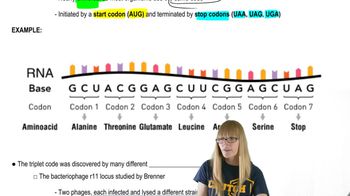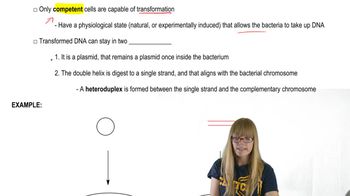Which of the following codons is a start codon?
Table of contents
- 1. Introduction to Genetics51m
- 2. Mendel's Laws of Inheritance3h 37m
- 3. Extensions to Mendelian Inheritance2h 41m
- 4. Genetic Mapping and Linkage2h 28m
- 5. Genetics of Bacteria and Viruses1h 21m
- 6. Chromosomal Variation1h 48m
- 7. DNA and Chromosome Structure56m
- 8. DNA Replication1h 10m
- 9. Mitosis and Meiosis1h 34m
- 10. Transcription1h 0m
- 11. Translation58m
- 12. Gene Regulation in Prokaryotes1h 19m
- 13. Gene Regulation in Eukaryotes44m
- 14. Genetic Control of Development44m
- 15. Genomes and Genomics1h 50m
- 16. Transposable Elements47m
- 17. Mutation, Repair, and Recombination1h 6m
- 18. Molecular Genetic Tools19m
- 19. Cancer Genetics29m
- 20. Quantitative Genetics1h 26m
- 21. Population Genetics50m
- 22. Evolutionary Genetics29m
11. Translation
The Genetic Code
Problem 1b
Textbook Question
What experimental evidence provided the initial insights into the compositions of codons encoding specific amino acids?
 Verified step by step guidance
Verified step by step guidance1
Step 1: Understand the concept of codons and their role in encoding amino acids. Codons are sequences of three nucleotides in mRNA that correspond to specific amino acids during protein synthesis. The genetic code is universal and consists of 64 codons, including start and stop signals.
Step 2: Review the historical experiments that provided evidence for codon composition. One key experiment was conducted by Marshall Nirenberg and Heinrich Matthaei in 1961, where they used synthetic RNA sequences to determine which codons corresponded to specific amino acids. This was achieved by creating poly-U RNA (repeating uracil bases) and observing the production of phenylalanine.
Step 3: Explore the use of cell-free systems in these experiments. Nirenberg and Matthaei used a cell-free protein synthesis system, which allowed them to add synthetic RNA to a mixture containing ribosomes, tRNAs, and amino acids. This system enabled the translation of RNA into proteins outside of living cells.
Step 4: Examine the role of radioactive labeling in identifying amino acids. In these experiments, amino acids were radioactively labeled, allowing researchers to track which amino acids were incorporated into proteins based on the synthetic RNA sequences provided.
Step 5: Consider the extension of these experiments by other researchers, such as Har Gobind Khorana, who synthesized RNA molecules with defined sequences to systematically decode the genetic code. These studies confirmed the triplet nature of codons and identified the specific codons for all 20 amino acids.
 Verified video answer for a similar problem:
Verified video answer for a similar problem:This video solution was recommended by our tutors as helpful for the problem above
Video duration:
2mPlay a video:
Was this helpful?
Key Concepts
Here are the essential concepts you must grasp in order to answer the question correctly.
Codons
Codons are sequences of three nucleotides in mRNA that correspond to specific amino acids during protein synthesis. Each codon is part of the genetic code, which dictates how sequences of nucleotides are translated into proteins. Understanding codons is essential for grasping how genetic information is expressed and how mutations can affect protein function.
Recommended video:
Guided course

The Genetic Code
Experimental Evidence
Experimental evidence refers to the data and observations collected through scientific experiments that support or refute a hypothesis. In the context of codons, key experiments, such as those conducted by Marshall Nirenberg and Heinrich Matthaei, demonstrated how specific codons correspond to specific amino acids, providing foundational insights into the genetic code.
Recommended video:
Guided course

Transformation
Transcription and Translation
Transcription is the process by which genetic information in DNA is copied into messenger RNA (mRNA), while translation is the subsequent process where ribosomes synthesize proteins based on the sequence of codons in the mRNA. Understanding these processes is crucial for comprehending how genetic information is expressed and how it leads to the formation of proteins, which are vital for cellular functions.
Recommended video:
Guided course

Translation initiation
Related Videos
Related Practice
Multiple Choice
614
views
3
rank


